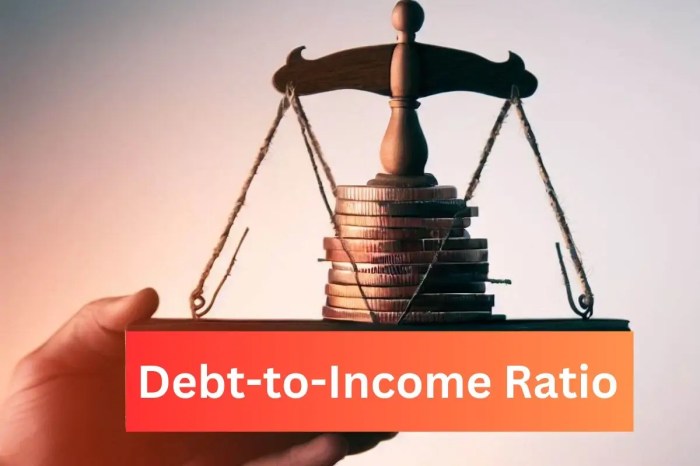Best debt-to-income ratio for car loans? It’s a crucial question for anyone looking to buy a car. Your debt-to-income ratio (DTI), essentially how much you owe compared to how much you earn, is a major factor in whether you get approved for a loan and what interest rate you’ll pay. Understanding your DTI and how it impacts your car loan options is key to getting the best deal.
This guide breaks down everything you need to know, from calculating your DTI to finding strategies to improve it.
We’ll explore how different types of debt – credit cards, student loans, mortgages – all factor into your DTI. We’ll also look at how lenders use your DTI to assess your risk, and how that impacts your interest rate and monthly payments. Plus, we’ll discuss ways to boost your DTI and explore alternative financing options if you’re facing challenges.
Understanding Debt-to-Income Ratio (DTI) for Car Loans

Your debt-to-income ratio (DTI) is a crucial factor lenders consider when you apply for a car loan. It essentially shows how much of your monthly income is already committed to paying off debt. A lower DTI generally means a better chance of loan approval and potentially more favorable interest rates. Understanding how DTI is calculated and what influences it is key to securing the best possible car loan.
Debt-to-Income Ratio Calculation
Calculating your DTI involves determining your total monthly debt payments and dividing that by your gross monthly income. Your gross monthly income is your income before taxes and other deductions. Total monthly debt payments include all recurring debt obligations, not just the ones you’re actively trying to pay off.
DTI = (Total Monthly Debt Payments) / (Gross Monthly Income)
For example, if your total monthly debt payments are $1,500 and your gross monthly income is $5,000, your DTI is 30% (1500/5000 = 0.30). This is typically expressed as a percentage.
Impact of Various Debt Types on DTI
Various types of debt contribute to your DTI. Credit card debt, mortgages, student loans, and auto loan payments all factor into the calculation. Each debt type carries different weight based on the monthly payment amount. A large mortgage payment will significantly impact your DTI more than several smaller credit card payments.For instance, a large student loan payment could push your DTI higher, potentially affecting your ability to qualify for a car loan with favorable terms.
Conversely, diligently paying down high-interest credit card debt can lower your DTI, making you a more attractive borrower.
Examples of DTI and Loan Approval
Let’s illustrate how different debt levels affect DTI scores and loan approval.Imagine two individuals, both earning $5,000 per month.* Individual A: Has $1,000 in monthly debt payments (20% DTI). They’re likely to qualify for a car loan with favorable terms.
Individual B
Has $3,000 in monthly debt payments (60% DTI). They may struggle to get approved for a car loan, or they might receive a higher interest rate due to the higher risk perceived by the lender.
Landing a sweet car loan hinges on having a killer debt-to-income ratio, ideally under 36%. But if your credit history’s a little shaky, you might need a cosigner to boost your chances. Check out the specifics on Cosigner requirements for auto loans 2025 to see how a cosigner can help you get approved, even with a slightly higher DTI.
Ultimately, a lower DTI makes getting that loan way easier, cosigner or not.
DTI Ratios and Car Loan Approval Implications
| DTI Ratio | Loan Approval Likelihood | Interest Rate Expectations | Additional Considerations |
|---|---|---|---|
| Below 36% | High | Likely favorable | Strong chance of approval with competitive rates. |
| 36-43% | Moderate | Potentially higher | Approval possible, but may require a larger down payment or higher interest rate. |
| Above 43% | Low | Significantly higher or loan denial | Approval is less likely. Consider debt reduction before applying. |
Ideal DTI for Car Loan Approval
Landing that sweet ride depends heavily on your debt-to-income ratio (DTI). Lenders use your DTI to assess your ability to repay a loan, so understanding what’s considered ideal is crucial for getting approved. Basically, a lower DTI means you have more breathing room financially, making you a less risky borrower.Lenders generally prefer applicants with a DTI below 43%, although this isn’t a hard and fast rule.
The specific DTI threshold varies significantly based on several key factors. A lower DTI often translates to better loan terms, such as lower interest rates. Aiming for a DTI in the lower ranges increases your chances of approval and securing favorable financing.
Factors Influencing Lender DTI Requirements
Several factors influence a lender’s DTI requirements beyond just the raw number. Credit score plays a huge role; a higher credit score can often offset a slightly higher DTI. The type of car loan (new vs. used) also matters, as lenders might be more lenient with used car loans. The loan amount itself is a factor, with smaller loans carrying less risk.
Finally, the lender’s own risk tolerance varies, leading to differences in DTI acceptance levels. A more conservative lender might have a stricter DTI threshold than a more aggressive one.
DTI Expectations of Different Lenders, Best debt-to-income ratio for car loans
Banks, credit unions, and online lenders often have different DTI expectations. Banks, generally more risk-averse, might prefer DTIs below 36%, while credit unions, known for member focus, might be slightly more flexible. Online lenders, operating with a higher volume of applications, sometimes have automated systems that might allow for slightly higher DTIs, but they often charge higher interest rates to compensate for the increased risk.
It’s important to shop around and compare offers from different lenders to find the best fit for your financial situation.
Strategies to Improve DTI Before Applying for a Car Loan
Before applying for a car loan, improving your DTI can significantly increase your chances of approval. Here are some effective strategies:
- Pay down existing debt: Focus on reducing high-interest debt, like credit cards, before applying for a car loan. Even small payments can make a difference.
- Increase your income: If possible, seek a raise or a higher-paying job to boost your income and lower your DTI.
- Negotiate lower interest rates on existing debt: Contact your creditors to see if they’re willing to lower your interest rates. This can reduce your monthly payments and improve your DTI.
- Consider a shorter loan term: A shorter loan term will result in higher monthly payments, but it will also reduce the total interest paid over the life of the loan and potentially lower your DTI.
- Save for a larger down payment: A larger down payment reduces the loan amount, directly impacting your DTI.
Impact of DTI on Interest Rates

Your debt-to-income ratio (DTI) is a major factor in determining the interest rate you’ll get on a car loan. Lenders use your DTI to assess your ability to repay the loan, and a higher DTI generally means a higher risk for them. This increased risk translates directly into a higher interest rate for you, meaning more expensive monthly payments and a higher overall cost for the car.Lenders view a lower DTI as a sign of responsible financial management, indicating a greater likelihood of loan repayment.
This lower perceived risk allows them to offer more favorable interest rates. Conversely, a high DTI suggests you’re already stretched financially, increasing the chance you might struggle to make your car payments. This leads lenders to offer higher interest rates to compensate for the added risk.
Interest Rate Differences Based on DTI
The impact of DTI on interest rates can be significant. Let’s say you’re looking at a $25,000 car loan. With a DTI of 10%, you might qualify for an interest rate of 4%, resulting in a monthly payment of approximately $450 (assuming a 60-month loan). However, if your DTI is 40%, the same loan might carry an interest rate of 7%, increasing your monthly payment to roughly $485.
That seemingly small difference in interest rate adds up to a substantial increase in total interest paid over the life of the loan – potentially thousands of dollars more.
Illustrative DTI and Interest Rate Relationship
The following table illustrates the potential relationship between DTI and interest rates for a $25,000, 60-month car loan. Remember, these are examples and actual rates can vary depending on the lender, your credit score, and other factors.
| DTI Ratio | Approximate Interest Rate | Approximate Monthly Payment | Total Interest Paid (Estimate) |
|---|---|---|---|
| 10% | 4% | $450 | $2,980 |
| 20% | 5% | $470 | $4,180 |
| 30% | 6% | $490 | $5,380 |
| 40% | 7% | $485 | $6,600 |
Potential Cost Savings of Lower DTI
The potential cost savings associated with a lower DTI are substantial. By diligently managing your debt and maintaining a lower DTI, you can significantly reduce the interest you pay over the life of your car loan. In the examples above, the difference between a 10% DTI and a 40% DTI could mean an extra $3,620 in interest paid over five years.
That’s money you could use for other things, like paying down other debts, saving for a down payment on a house, or investing. This emphasizes the importance of striving for a lower DTI before applying for a car loan.
Strategies for Improving DTI
So, you’re looking to improve your debt-to-income ratio (DTI) to snag that sweet car loan? No problem! Improving your DTI is totally achievable with a bit of planning and effort. This section Artikels effective strategies to boost your chances of approval and potentially even secure a better interest rate.
Reducing Existing Debt
Tackling existing debt is key to lowering your DTI. High credit card balances and other loans significantly impact your DTI calculation. A multi-pronged approach is often most effective. Prioritizing high-interest debts, like credit cards, can save you money in the long run and quickly improve your DTI. Consider using the debt avalanche or debt snowball method to strategically pay down your debts.
The debt avalanche method focuses on paying off the debt with the highest interest rate first, while the debt snowball method focuses on paying off the smallest debt first for psychological motivation. Both methods can significantly reduce your overall debt and improve your DTI. Remember, consistency is key! Make consistent, even small, payments towards your debts.
So, you’re trying to figure out the best debt-to-income ratio for car loans, right? A lower ratio is always better for your credit score. But if you’re eyeing something a little fancier, maybe check out some sweet deals – like those listed on this site for Best lease deals for luxury cars 2025 – before committing to a loan.
Remember, though, even a killer lease impacts your debt-to-income ratio, so plan accordingly!
Managing Monthly Expenses
Managing monthly expenses is crucial for lowering your DTI. This involves carefully reviewing your spending habits and identifying areas where you can cut back. Start by tracking your expenses for a month to pinpoint where your money is going. Then, look for areas where you can reduce spending, such as eating out less, canceling unused subscriptions, or finding cheaper alternatives for everyday expenses.
Budgeting apps and spreadsheets can be helpful tools for tracking and managing your expenses. Even small reductions in monthly spending can make a noticeable difference in your DTI over time. For example, cutting $100 a month in spending could save you $1200 a year, which could significantly impact your debt repayment and lower your DTI.
Increasing Income
Boosting your income is another effective way to improve your DTI. A higher income means a lower DTI, even if your debt remains the same. Consider exploring opportunities for a raise at your current job, taking on a side hustle, or seeking a higher-paying position. Freelancing, gig work, or part-time jobs can supplement your income and contribute to faster debt repayment.
The extra income can be directed towards paying down debt, lowering your DTI, and improving your financial situation. For instance, a $500 increase in monthly income could drastically improve your DTI, especially if allocated towards debt repayment.
Debt Consolidation
Debt consolidation can simplify your debt repayment and potentially improve your DTI. This involves combining multiple debts into a single loan, often with a lower interest rate. This can lead to lower monthly payments, making it easier to manage your debt and reduce your DTI. However, it’s crucial to carefully compare interest rates and fees before consolidating your debts.
A lower interest rate can significantly reduce your overall debt burden and positively impact your DTI. For example, consolidating high-interest credit card debt into a lower-interest personal loan can lead to substantial savings and a lower DTI. It’s always advisable to shop around and compare offers from different lenders before making a decision.
Alternatives to Traditional Car Loans: Best Debt-to-income Ratio For Car Loans
So, you’ve crunched the numbers and your debt-to-income ratio (DTI) is a little higher than lenders ideally prefer. Don’t panic! There are still ways to get behind the wheel of a new or used car. This section explores alternative financing options that might be a better fit for your financial situation.
Traditional car loans aren’t the only game in town. If your DTI is preventing you from securing a loan with favorable terms, several alternative financing methods can help you acquire a vehicle. Understanding the pros and cons of each option is crucial for making an informed decision that aligns with your budget and long-term financial goals.
Alternative Financing Options for High DTI Individuals
Several options exist for individuals with high DTIs seeking car financing. These include dealer financing, which sometimes offers more lenient approval criteria, though often at higher interest rates. Another option is securing a co-signer on a traditional loan; a co-signer with good credit can significantly improve your chances of approval. Finally, exploring personal loans, while not specifically designed for car purchases, can provide funding for the vehicle, though repayment terms might differ from a dedicated auto loan.
Each option carries its own set of advantages and disadvantages that should be carefully weighed.
Leasing Versus Buying a Car
Leasing and buying a car represent distinct approaches to vehicle ownership, each with its own financial implications. Leasing involves paying for the right to use a vehicle for a set period, typically two to three years, after which you return the car. Buying, on the other hand, involves securing a loan to purchase the vehicle outright, with the goal of owning it free and clear once the loan is repaid.
Leasing typically requires lower upfront payments and monthly installments compared to buying, making it potentially more attractive for individuals with tighter budgets or high DTIs. However, leasing comes with mileage restrictions and potential penalties for early termination. Buying offers more flexibility and long-term ownership benefits, but requires a larger down payment and higher monthly payments. The best option depends on individual needs and financial circumstances.
Situations Where Alternative Financing Might Be Preferable
Alternative financing options can be particularly beneficial in specific scenarios. For instance, if you have a high DTI but anticipate a significant increase in income soon, a slightly higher interest rate on a dealer loan might be a worthwhile temporary compromise. Similarly, if your credit score is below average, but you have a trusted co-signer with excellent credit, a traditional loan with a co-signer could provide better terms than alternative options.
Finally, if you need a car quickly and have sufficient savings to handle a higher interest rate, a personal loan might be a viable solution.
Comparison of Financing Options
| Financing Option | Pros | Cons | DTI Suitability |
|---|---|---|---|
| Traditional Auto Loan | Potentially lower interest rates, predictable payments, build equity | Stricter approval requirements, higher DTI needed for approval | Low to Moderate DTI |
| Dealer Financing | Easier approval for those with high DTI | Often higher interest rates, less favorable terms | High DTI |
| Co-signed Auto Loan | Improved approval chances with a co-signer, potentially better rates | Requires a reliable co-signer with good credit | High DTI with a reliable co-signer |
| Personal Loan | Flexibility in use of funds | Potentially higher interest rates, no vehicle equity built | High DTI, but requires sufficient creditworthiness |
Illustrative Scenarios

Let’s look at some real-world examples to see how debt-to-income ratio (DTI) affects car loan applications. Understanding these scenarios will help you grasp the importance of DTI in securing favorable loan terms.
Low DTI Scenario and its Impact
Imagine Sarah, a recent college grad with a stable job earning $40,000 annually. Her only debt is a student loan payment of $300 per month. Her total monthly debt payments are therefore $300. Her gross monthly income is approximately $3333. This gives her a DTI of roughly 9%, a very low number.
When she applies for a car loan, lenders will view her application favorably. Her low DTI indicates a low risk to the lender, resulting in a high probability of loan approval and potentially a lower interest rate, saving her money over the life of the loan. She’s likely to get approved for a loan with better terms than someone with a higher DTI.
High DTI Scenario and its Impact
Now consider Mark, who earns $50,000 annually but has significant debt from credit cards, student loans, and a personal loan, totaling $2000 in monthly payments. His gross monthly income is approximately $4167. His DTI is a high 48%. When Mark applies for a car loan, lenders will see his high DTI as a significant risk. Approval is less certain, and if he is approved, he’ll likely face a higher interest rate to compensate the lender for the increased risk.
The higher interest rate will increase his monthly payments and the total cost of the car over time. He might even be denied a loan altogether.
Hypothetical Individual’s Financial Situation
Let’s analyze the situation of Jessica, a nurse earning $75,000 annually. Her monthly income is approximately $6250. She has a mortgage payment of $1500, a student loan payment of $400, and a credit card payment of $200. Her total monthly debt payments are $2100. This results in a DTI of approximately 34%.
Jessica’s DTI falls within a moderate range. While she’s likely to be approved for a car loan, the interest rate she receives will likely be higher than Sarah’s due to her higher DTI. Lenders will assess her application carefully, considering her stable income and the type of car she’s financing. The outcome is less certain than Sarah’s, but a loan approval is still probable.
Graph Showing the Relationship Between DTI and Loan Approval Probability
Imagine a line graph. The x-axis represents the DTI, ranging from 0% to 100%. The y-axis represents the probability of loan approval, ranging from 0% (no chance of approval) to 100% (guaranteed approval). The line starts at near 100% probability at a DTI of 0%, gradually sloping downwards as DTI increases. The slope is initially gradual, becoming steeper around a DTI of 30-40%.
At a DTI above 50%, the probability of approval drops sharply, approaching 0% as DTI nears 100%. The graph clearly illustrates the inverse relationship between DTI and the likelihood of loan approval. The higher the DTI, the lower the chance of getting approved for a car loan, especially at favorable interest rates.
Outcome Summary
Securing a car loan hinges significantly on your debt-to-income ratio. By understanding how your DTI is calculated and what lenders look for, you can proactively improve your financial standing to get the best possible loan terms. Remember, lowering your DTI can translate to lower interest rates and more affordable monthly payments, ultimately saving you money in the long run.
Don’t hesitate to explore alternative financing options if needed – there are paths to car ownership even with a higher DTI. So, crunch those numbers, plan strategically, and get ready to drive off in your dream car!









